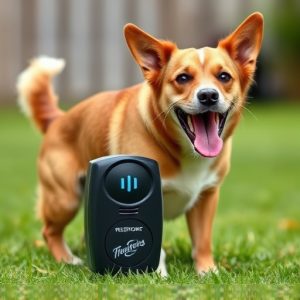Ultrasonic Systems for Customized Bark Control: Mastering Canine Behavior Modification
Canine behavior modification ultrasonic systems use high-frequency sounds to discourage excessive ba…….
Canine behavior modification ultrasonic systems use high-frequency sounds to discourage excessive barking without causing harm. The key feature is Customize Bark Control Intensity Settings, allowing owners to adjust volume and frequency based on their dog's sensitivity and training progress. Regular monitoring of the dog's reaction is crucial for humane and effective training, which involves gradually increasing intensity settings until a level prompts reevaluation without discomfort. Consistent practice sessions lead to successful behavior modification over time, with ongoing research exploring smarter systems utilizing artificial intelligence.
“Unleash the power of sound to transform your canine companion’s behavior with innovative ultrasonic systems. This comprehensive guide explores the science behind dog training, delving into how these devices work and their effectiveness in modifying unwanted actions like excessive barking. We demystify ‘Customize Bark Control: Intensity Settings’, offering insights into adjusting the volume for optimal results. From understanding canine behavior to advanced tech trends, this article is your roadmap to harnessing the potential of ultrasonic systems for a harmonized human-canine relationship.”
- Understanding Canine Behavior and Ultrasonic Systems
- Customizing Bark Control: Intensity Settings Explained
- Effective Implementation Strategies for Optimal Results
- Advanced Features and Future Developments in Dog Training Technology
Understanding Canine Behavior and Ultrasonic Systems
Canine behavior is complex and multifaceted, influenced by a combination of innate instincts, past experiences, and current environments. Understanding these nuances is crucial when employing any modification technique, including ultrasonic systems. These devices use high-frequency sound waves to disrupt or discourage unwanted behaviors like excessive barking. By adjusting the intensity settings on these systems, owners can customize the training experience to their dog’s specific needs and sensitivity levels.
Ultrasonic bark control systems are particularly effective because dogs hear sounds at a higher frequency than humans. This allows for precise targeting of the canine auditory system without causing harm or distress. The ability to tailor the intensity settings means that these systems can be used for mild, moderate, or severe behavioral issues, ensuring a safe and effective training tool for responsible dog ownership.
Customizing Bark Control: Intensity Settings Explained
Canine behavior modification ultrasonic systems offer a way to train dogs by emitting a high-frequency sound that is unpleasant to them when they bark excessively. One key aspect of these systems is their ability to customize the Bark Control Intensity Settings. This feature allows owners to adjust the volume and frequency of the ultrasonic signal based on their dog’s sensitivity and training progress. Starting with lower intensity levels, owners can gradually increase the setting as their dog becomes more accustomed to the correction, ensuring a safe and effective training process.
Understanding these Intensity Settings is crucial for responsible use. For instance, some dogs may respond better to a slightly higher pitch, while others require a quieter sound. By customizing these settings, owners can avoid over-stimulating their pets and reinforce good behavior in a positive way. Regular monitoring of the dog’s reaction is essential, as it helps in quickly adjusting the intensity if needed, ensuring the training remains humane and effective.
Effective Implementation Strategies for Optimal Results
When implementing a canine behavior modification ultrasonic system, customization is key for optimal results. The ability to adjust and fine-tune the bark control intensity settings allows for a tailored approach that caters to each dog’s unique needs and sensitivities. Start by evaluating your dog’s reaction to the initial setting; if they appear distressed or indifferent, gradually increase the intensity until you find a level that prompts them to reevaluate their behavior without causing excessive discomfort. Consistently monitor their response, making adjustments as needed, for a more effective training experience.
Additionally, ensure the system is triggered by specific barking behaviors rather than general noise. This customization prevents unnecessary activation and reinforces positive reinforcement techniques. By teaching your dog which barks prompt the ultrasonic response, you enhance their understanding of desired behavior. Regular practice sessions, combined with consistent application of the modified settings, will lead to more successful behavior modification over time.
Advanced Features and Future Developments in Dog Training Technology
The future of canine behavior modification technology looks promising, with advancements pushing the boundaries of what’s possible in dog training. One notable trend is the integration of sophisticated features in ultrasonic systems, designed to address specific barking issues. These devices now offer customizable bark control intensity settings, allowing for a more tailored and effective approach to modifying unwanted behaviors. By adjusting the frequency and volume of ultrasonic signals, owners can gently encourage their dogs to stop barking excessively without causing discomfort or stress.
Additionally, ongoing research focuses on developing smarter, more responsive systems that can learn from individual dog behaviors. This includes the potential use of artificial intelligence (AI) to recognize unique barks and tailor interventions accordingly. As technology evolves, we can expect even more innovative solutions to emerge, enhancing the bond between humans and their canine companions while promoting positive and effective behavior modification practices.
The canine behavior modification ultrasonic system, by leveraging tailored bark control intensity settings and strategic implementation, offers a safe and effective approach to addressing unwanted dog barking. By understanding canine behavior and customizing the system to meet individual needs, owners can foster positive reinforcement and promote desirable behavioral changes in their pets. As technology advances, future developments promise even more sophisticated tools for responsible and humane dog training.


